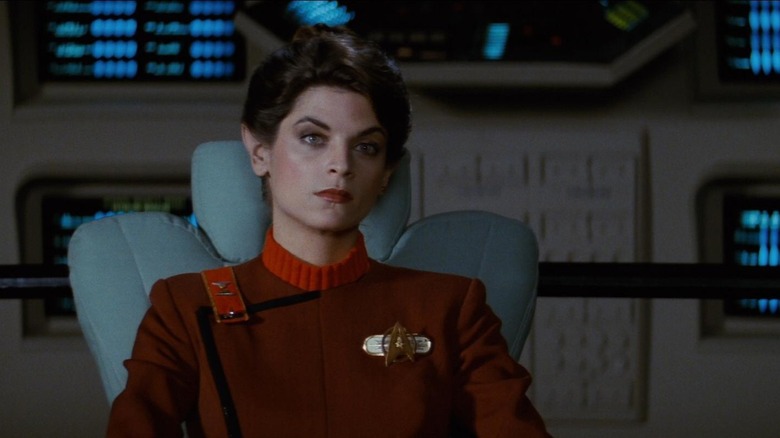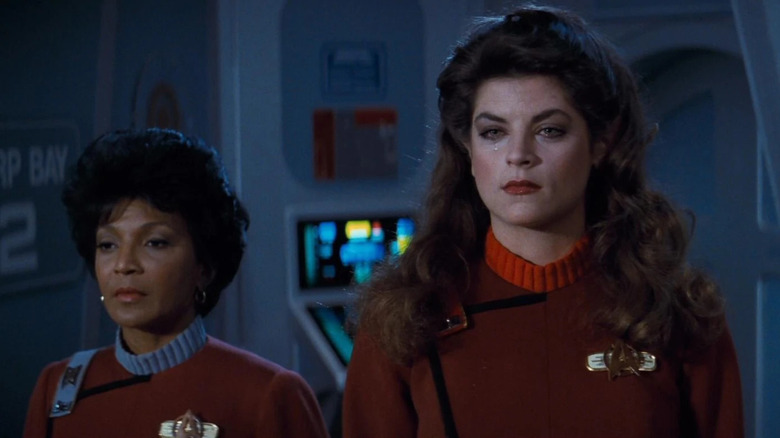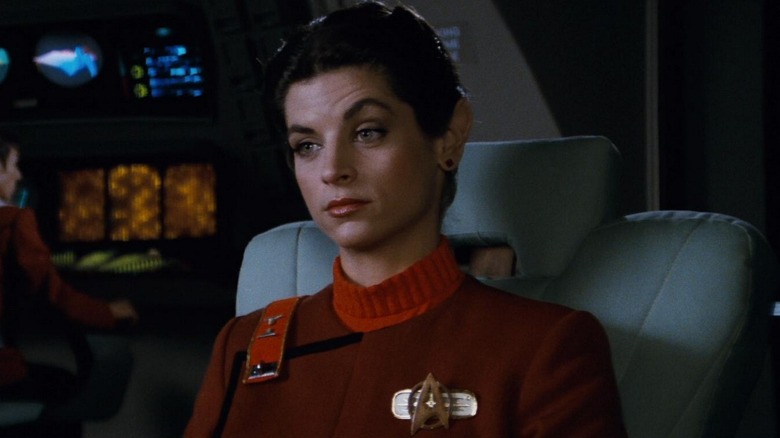Kirstie Alley Proved There Was Room For Vulcan Characters In Star Trek Beyond Spock
Given the ubiquity and cultural penetration of "Star Trek," it may take some imagination to picture just how strange Vulcans were in 1966. Possessed of angled eyebrows and Mephistophelean ears, Vulcans were cold and logical and, well, inhuman, having rejected their emotional impulses in favor of intellect. The first Vulcan audiences ever saw was Spock (Leonard Nimoy), who brought a level of dry formalism to "Star Trek" that has remained a central feature of the franchise ever since. Spock, the first officer on the U.S.S. Enterprise, eventually became the most recognizable character on "Star Trek," with audiences intrigued by his intellectual life. However, Spock was eventually revealed to be half human, giving "Star Trek" writers an organic excuse to show cracks in Spock's otherwise upright demeanor.
Anecdotally, several friends have revealed that their favorite parts of the original "Star Trek" series were the instances when Spock "lost his cool." When he laughed or got angry. "Amok Time," the episode wherein Spock finds himself needing to mate (a once-every-seven-years impulse for Vulcans), provided ample opportunity for Spock to fight, to laugh, and to be horny. Many liked that Spock was logical, but loved that he was occasionally human.
For the ultra-nerdy "Star Trek" purists — like this author — Spock was more intriguing when he kept his cool. The appeal of the character was that he had devoted himself to a life of emotionlessness ... and seemed to be doing just fine. Spock offered a tantalizing look into an alternate sci-fi culture that, presumably, inflamed the imaginations of the viewers. What "Star Trek" needed to complete that notion was a full-blooded Vulcan.
We got one in Saavik, played by the late Kirsie Alley.
Saavik
While "Star Trek" had seen several full-blooded Vulcans before — T'Pring (Arlene Martel) notably appeared in "Amok Time" — Lt. Saavik was the first full-blooded Vulcan to have a major role on the U.S.S. Enterprise. In Nicholas Meyer's 1982 feature film "Star Trek II: The Wrath of Khan," Lt. Saavik is first seen engaged in a specialized Starfleet test called the Kobayashi Maru. The test puts the student in a simulation wherein they serve as a starship captain, and are ordered to rescue a civilian vessel from a fleet of Klingons. In "Star Trek II," Saavik is seated in the captain's chair before the audiences is given that context. It looks like she is giving orders to Sulu (George Takei) and Uhura (Nichelle Nichols), perhaps as the new captain of the Enterprise. It isn't until she fails the test that its nature as a simulation is revealed.
Saavik spends several scenes of "Star Trek II" discussing humanity with Spock, and seems entirely skeptical of serving on a majority-human ship. She is always cool and collected, more baffled than annoyed.
Saavik might be seen, functionally at least, as a "reboot" of Spock. By 1982, Nimoy was 51 years old, and Spock was no longer a naïf on the Enterprise. He knew Captain Kirk (William Shatner) quite well, and had come to accept — and even sometimes appreciate — the illogic of his crewmates. Saavik was relatively inexperienced, and had the same questions about humans that Spock had back in 1966. It was refreshing to have a familiar dynamic back in "Star Trek" without fundamentally altering the baseline chemistry of the original crew or rebooting the entire franchise. Saavik was a savvy addition.
Star Trek, the next generation
Despite Lt. Saavik's structural function, however, she was also a fully realized character all her own. She was wry, even humorous ... in that Vulcan kind of way. She seemed to better understand the ways of the world than Spock ever did. "Star Trek II" came out in the early 1980s, and the world had changed, as had the characters on the show. A big theme of "Star Trek II" is Kirk's aging. He has to wear glasses, and face a no-win scenario in real life. As a youth, Kirk cheated on the Kobayashi Maru. As an adult, he might actually have to face loss. The world is moving faster than he is.
Lt. Saavik was, well, "Star Trek," the next generation. She was more comfortable, brighter, faster than the middle-aged people around her (Alley was 29 at time of filming). And she was, thanks to Alley's committed performance, quite likeable. Lt. Saavik was, for the first time, a Vulcan we understood entirely. Thanks to 16 years with Spock, audiences knew what Vulcans were all about, and Lt. Saavik was no longer burdened with needing to explain her own culture to the audience.
As such, Lt. Saavik could be appreciated from the start. She may still acquire experience as a Starfleet officer — she is only a lieutenant — but she is immediately welcomed as a new addition to the crew. Not just by Kirk and co., but by us.
Having a new Vulcan character on "Star Trek" instantly expanded the mythology of the show. Here, finally, was access to Vulcan culture outside the purview of Spock's personal experience. She was a new angle, a new philosophy, a new compatriot.
R.I.P. Kirstie Alley. Trekkies thank you.


